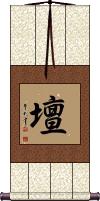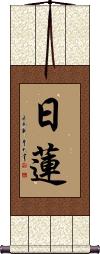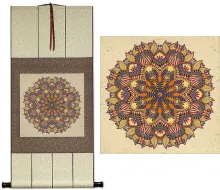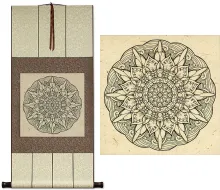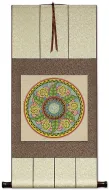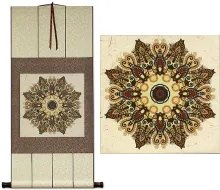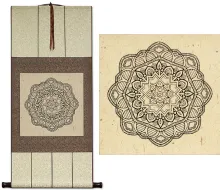Many custom options...
And formats...

Mandala in Chinese / Japanese...
Buy a Mandala calligraphy wall scroll here!
Personalize your custom “Mandala” project by clicking the button next to your favorite “Mandala” title below...
Mandala / Altar
壇 is the Chinese, Japanese Kanji, and old Korean Hanja for mandala or altar.
This can also mean platform, podium, rostrum, or “objects of worship grouped together.”
In Japanese, this can be the given name Mayumi.
Nichiren
日蓮 is the title Nichiren.
This title refers to a Buddhist priest who lived from 1222 to 1282. He is the founder of the Nichiren sect of Buddhism.
According to historical documents, the Nichiren sect was established in 1252. Adding the character 宗 for sect, this would be 日蓮宗 (Nichiren sect), which is also known as the 法華宗 or Lotus sect.
According to Soothill-Hodous...
Nichiren's chief tenets are the three great mysteries 三大祕法, representing the trikāya:
1. 本尊 or chief object of worship, being the great maṇḍala of the worlds of the ten directions, or universe, i.e., the body or nirmāṇakāya of Buddha.
2. 題目 the title of the Lotus Sutra 妙法蓮華經 Myo-ho-ren-ge-kyo, preceded by Namo, or “Adoration to the scripture of the lotus of the wonderful law,” for it is Buddha's spiritual body.
3. 戒壇 the altar of the law, which is also the title of the Lotus as above; the believer, wherever he is, dwells in the Pure-land of calm light 寂光淨土, the saṃbhogakāya.
This in-stock artwork might be what you are looking for, and ships right away...
Gallery Price: $96.00
Your Price: $52.88
Gallery Price: $90.00
Your Price: $49.88
Gallery Price: $63.00
Your Price: $34.88
Gallery Price: $72.00
Your Price: $39.88
Gallery Price: $63.00
Your Price: $34.88
Gallery Price: $70.00
Your Price: $38.88
Gallery Price: $72.00
Your Price: $39.88
Gallery Price: $72.00
Your Price: $39.88
Starting at: $28.88
Gallery Price: $72.00
Your Price: $39.88
Gallery Price: $101.00
Your Price: $55.88
Gallery Price: $108.00
Your Price: $59.88
Not the results for mandala that you were looking for?
Below are some entries from our dictionary that may match your mandala search...
| Characters If shown, 2nd row is Simp. Chinese |
Pronunciation Romanization |
Simple Dictionary Definition |
壇 坛 see styles |
tán tan2 t`an tan dan だん |
More info & calligraphy: Mandala / Altar(1) platform; podium; rostrum; pulpit; (2) (ceremonial) mound; (suffix noun) (3) world (of haiku, art, etc.); (literary) circles; (4) (archaism) mandala; (given name) Mayumi An altar; an open altar. In the esoteric cult it also means a maṇḍala, objects of worship grouped together. |
日蓮 日莲 see styles |
rì lián ri4 lian2 jih lien nichiren にちれん |
More info & calligraphy: NichirenNichiren, the Japanese founder, in A. D. 1252, of the 日蓮宗 Nichiren sect, which is also known as the 法華宗 or Lotus sect. Its chief tenets are the three great mysteries 三大祕法, representing the trikāya: (1) 本尊 or chief object of worship, being the great maṇḍala of the worlds of the ten directions, or universe, i. e. the body or nirmāṇakāya of Buddha; (2) 題目 the title of the Lotus Sutra 妙法蓮華經 Myo-ho-ren-gwe-kyo, preceded by Namo, or, 'Adoration to the scripture of the lotus of the wonderful law, ' for it is Buddha's spiritual body; (3) 戒壇 the altar of the law, which is also the title of the Lotus as above; the believer, wherever he is, dwells in the Pure-land of calm light 寂光淨土, the saṃbhogakāya. |
一識 一识 see styles |
yī shì yi1 shi4 i shih isshiki |
One sense or perception; the one individual intelligence or soul which uses the various senses, likened to a monkey which climbs in and out of the various windows of a house— a Satyasiddhi and Sautrāntika doctrine. Also, a Vairocana maṇḍala. |
中台 see styles |
chuudai / chudai ちゅうだい |
(1) (rare) exact center of the Garbhadhatu mandala; (2) platform upon which the fire is lit in a stone lantern; (place-name, surname) Nakadai |
中胎 see styles |
zhōng tāi zhong1 tai1 chung t`ai chung tai chūtai |
(中胎藏) The central figure of the eight-petalled group of the Garbhadhātu maṇḍala; i. e. the phenomenal Vairocana who has around him four Buddhas and four bodhisattvas, each on a petal. From this maṇḍala spring the four other great maṇḍalas. |
九會 九会 see styles |
jiǔ huì jiu3 hui4 chiu hui ku e |
(九會曼陀羅) The nine groups in the diamond-realm maṇḍala. |
五部 see styles |
wǔ bù wu3 bu4 wu pu gohe ごへ |
(place-name) Gohe The five classes, or groups I. The 四諦 four truths, which four are classified as 見道 or theory, and 修道 practice, e. g. the eightfold path. II. The five early Hīnayāna sects, see 一切有部 or Sarvastivadah. III. The five groups of the Vajradhātu maṇḍala. |
光座 see styles |
guāng zuò guang1 zuo4 kuang tso kōza |
prabha-maṇḍala; the halo and throne (of a Buddha); also 光趺. |
內胎 内胎 see styles |
nèi tāi nei4 tai1 nei t`ai nei tai naitai |
inner tube (of a tire) The inner garbhadhātu, i. e. the eight objects in the eight leaves in the central group of the maṇḍala. |
四曼 see styles |
shiman しまん |
(abbreviation) {Buddh} (See 四種曼荼羅) four types of mandala (in Shingon) |
図像 see styles |
zuzou / zuzo ずぞう |
(1) icon; (2) {Buddh} simple ink drawing (of a buddha, mandala, etc.) |
圓壇 圆坛 see styles |
yuán tán yuan2 tan2 yüan t`an yüan tan endan |
Round altar; a complete group of objects of worship, a maṇḍala. |
大宝 see styles |
taihou; daihou / taiho; daiho たいほう; だいほう |
(1) great treasure; (2) (hist) Taihō era (701.3.21-704.5.10); Daihō era; (3) (rare) {Buddh} great treasure (used to refer to bodhisattvas, esoteric teachings, etc.); (4) (rare) {Buddh} (See 護摩壇) homa-mandala (fire altar); (place-name) Daihou |
大日 see styles |
dà rì da4 ri4 ta jih dainichi だいにち |
Mahavairocana (Tathagata); Great Sun; Supreme Buddha of Sino-Japanese esoteric Buddhism; (place-name, surname) Dainichi Vairocana, or Mahāvairocana 大日如來; 遍照如來; 摩訶毘盧遮那; 毘盧遮那; 大日覺王 The sun, "shining everywhere" The chief object of worship of the Shingon sect in Japan, "represented by the gigantic image in the temple at Nara." (Eliot.) There he is known as Dai-nichi-nyorai. He is counted as the first, and according to some, the origin of the five celestial Buddhas (dhyāni-buddhas, or jinas). He dwells quiescent in Arūpa-dhātu, the Heaven beyond form, and is the essence of wisdom (bodhi) and of absolute purity. Samantabhadra 普賢 is his dhyāni-bodhisattva. The 大日經 "teaches that Vairocana is the whole world, which is divided into Garbhadhātu (material) and Vajradhātu (indestructible), the two together forming Dharmadhātu. The manifestations of Vairocana's body to himself―that is, Buddhas and Bodhisattvas ―are represented symbolically by diagrams of several circles ". Eliot. In the 金剛界 or vajradhātu maṇḍala he is the center of the five groups. In the 胎藏界 or Garbhadhātu he is the center of the eight-leaf (lotus) court. His appearance, symbols, esoteric word, differ according to the two above distinctions. Generally he is considered as an embodiment of the Truth 法, both in the sense of dharmakāya 法身 and dharmaratna 法寳. Some hold Vairocana to be the dharmakāya of Śākyamuni 大日與釋迦同一佛 but the esoteric school denies this identity. Also known as 最高顯廣眼藏如來, the Tathagata who, in the highest, reveals the far-reaching treasure of his eye, i.e. the sun. 大日大聖不動明王 is described as one of his transformations. Also, a śramaņa of Kashmir (contemporary of Padma-saṃbhava); he is credited with introducing Buddhism into Khotan and being an incarnation of Mañjuśrī; the king Vijaya Saṃbhava built a monastery for him. |
大曼 see styles |
dà màn da4 man4 ta man dai man |
great maṇḍala |
寶生 宝生 see styles |
bǎo shēng bao3 sheng1 pao sheng hōshō |
Ratnasaṃbhava, one of the five dhyāni-buddhas, the central figure in the southern 'diamond' maṇḍala, The realm of Subhūti on his becoming Buddha. |
文殊 see styles |
wén shū wen2 shu1 wen shu monju もんじゅ |
Manjushri, the Bodhisattva of keen awareness (Buddhist term) Manjushri; Manjusri; Bodhisattva that represents transcendent wisdom; (p,s,f) Monju (文殊師利) Mañjuśrī 滿殊尸利 -later 曼殊室利. 文殊 is also used for Mañjunātha, Mañjudeva, Mañjughoṣa, Mañjuṣvara, et al. T., hjamdpal; J., Monju. Origin unknown; presumably, like most Buddhas and bodhisattvas, an idealization of a particular quality, in his case of Wisdom. Mañju is beautiful, Śrī; good fortune, virtue, majesty, lord, an epithet of a god. Six definitions are obtained from various scriptures: 妙首 (or 頭 ) wonderful or beautiful) head; 普首 universal head; 濡首 glossy head (probably a transliteration); 敬首 revered head; 妙德 wonderful virtue (or power); 妙吉祥 wonderfully auspicious; the last is a later translation in the 西域記. As guardian of wisdom 智慧 he is often placed on Śākyamuni's left, with 普顯 on the right as guardian of law 理, the latter holding the Law, the former the wisdom or exposition of it; formerly they held the reverse positions. He is often represented with five curls or waves to his hair indicating the 五智 q. v. or the five peaks; his hand holds the sword of wisdom and he sits on a lion emblematic of its stern majesty: but he has other forms. He is represented as a youth, i. e. eternal youth. His present abode is given as east of the universe, known as 淸涼山 clear and cool mountain, or a region 寶住 precious abode, or Abode of Treasures, or 寶氏 from which he derives one of his titles, 寶相如來. One of his dhāraṇīs prophesies China as his post-nirvāṇa realm. In past incarnations he is described as being the parent of many Buddhas and as having assisted the Buddha into existence; his title was 龍種上佛 the supreme Buddha of the nāgas, also 大身佛 or 神仙佛; now his title is 歡喜藏摩尼寶精佛 The spiritual Buddha who joyfully cares for the jewel: and his future title is to be 普現佛 Buddha universally revealed. In the 序品 Introductory Chapter of the Lotus Sutra he is also described as the ninth predecessor or Buddha-ancestor of Śākyamuni. He is looked on as the chief of the Bodhisattvas and represents them, as the chief disciple of the Buddha, or as his son 法王子. Hīnayāna counts Śāriputra as the wisest of the disciples, Mahāyāna gives Mañjuśrī the chief place, hence he is also styled 覺母 mother, or begetter of understanding. He is shown riding on either a lion or a peacock, or sitting on a white lotus; often he holds a book, emblem of wisdom, or a blue lotus; in certain rooms of a monastery he is shown as a monk; and he appears in military array as defender of the faith. His signs, magic words, and so on, are found in various sutras. His most famous centre in China is Wu-tai shan in Shansi. where he is the object of pilgrimages, especially of Mongols. The legends about him are many. He takes the place in Buddhism of Viśvakarman as Vulcan, or architect, of the universe. He is one of the eight Dhyāni-bodhisattvas, and sometimes has the image of Akṣobhya in his crown. He was mentioned in China as early as the fourth century and in the Lotus Sutra he frequently appears, especially as the converter of the daughter of the Dragon-king of the Ocean. He has five messengers 五使者 and eight youths 八童子 attending on him. His hall in the Garbhadhātu maṇḍala is the seventh, in which his group numbers twenty-five. His position is northeast. There are numerous sutras and other works with his name as title, e. g. 文殊師利問菩提經 Gayaśīrṣa sūtra, tr. by Kumārajīva 384-417: and its 論 or .Tīkā of Vasubandhu, tr. by Bodhiruci 535. see list in B. N. |
曼荼 see styles |
màn tú man4 tu2 man t`u man tu manda |
maṇḍala |
木曜 see styles |
mù yào mu4 yao4 mu yao mokuyou / mokuyo もくよう |
(See 木曜日) Thursday Jupiter, one of the 九曜 nine luminaries, q. v.; on the south of the diamond hall outside the Garbhadhātu maṇḍala. |
母主 see styles |
mǔ zhǔ mu3 zhu3 mu chu moshu |
The 'mother-lord', or mother, as contrasted with 主 and 母, lord and mother, king and queen, in the maṇḍala of Vajradhātu and Garbhadhātu; Vairocana, being the source of all things, has no 'mnother'as progenitor, and is the 部主 or lord of the maṇḍala; the other four dhyāni-buddhas have 'mothers' called 部母, who are supposed to arise from the paramitas; thus, Akṣobhya has 金剛波羅蜜 for mother; Ratnasaṃbhava has 寳波羅蜜 for mother; Amitābha has 法波羅蜜 for mother; Amoghasiddhi has 羯磨波羅蜜 for mother. |
輪圓 轮圆 see styles |
lún yuán lun2 yuan2 lun yüan rinen |
(輪圓具足) A complete maṇḍala showing the Buddhas and others, symbolizing their works; a magic circle. |
五大院 see styles |
wǔ dà yuàn wu3 da4 yuan4 wu ta yüan godaiin / godain ごだいいん |
(surname) Godaiin The fifth of the thirteen great courts of the Garbhadhātu-maṇḍala, named 持明院, the court of the five Dharmapālas 五大明王. |
十二宮 十二宫 see styles |
shí èr gōng shi2 er4 gong1 shih erh kung juunikyuu / junikyu じゅうにきゅう |
the twelve equatorial constellations or signs of the zodiac in Western astronomy and astrology, namely: Aries 白羊[Bai2 yang2], Taurus 金牛[Jin4 niu2], Gemini 雙子|双子[Shuang1 zi3], Cancer 巨蟹[Ju4 xie4], Leo 獅子|狮子[Shi1 zi3], Virgo 室女[Shi4 nu:3], Libra 天秤[Tian1 cheng4], Scorpio 天蠍|天蝎[Tian1 xie1], Sagittarius 人馬|人马[Ren2 ma3], Capricorn 摩羯[Mo2 jie2], Aquarius 寶瓶|宝瓶[Bao3 ping2], Pisces 雙魚|双鱼[Shuang1 yu2] constellations of the zodiac The twelve zodiacal mansions: east-gemini 夫婦 or 雙女; aries 羊; taurus 牛; west-libra 秤; scorpio 蝎; Sagittarius 弓 or人馬; south―aquarius 甁; pisces 魚; capri-cornus 密牛; north―cancer螃蟹; leo 獅子; virgo (or twin maidens 雙女). They are used in the vajradhātu group of the Garbhadhātu maṇḍala, E.W.S.N. |
大悲壇 大悲坛 see styles |
dà bēi tán da4 bei1 tan2 ta pei t`an ta pei tan daihi dan |
The altar of pity, a term for the garbhadhātu maṇḍala , or for the Sakyamumi group. |
忙忙鷄 忙忙鸡 see styles |
máng máng jī mang2 mang2 ji1 mang mang chi Mamakei |
忙葬鷄金剛 (or 忙葬計金剛); 麽麽鷄; 麽莫枳 Māmakī, or Māmukhī, tr. as 金剛母 the mother of all the vajra group, whose wisdom is derived from her; she is represented in the Garbhadhātu maṇḍala. |
捫打勒 扪打勒 see styles |
mén dǎ lè men2 da3 le4 men ta le monchōroku |
maṇḍala, v. 曼. |
曼怛羅 曼怛罗 see styles |
màn dá luó man4 da2 luo2 man ta lo mantanra |
or 曼特羅 v. below and 滿怛羅 are also used for mantra, an incantation, spell, magical formula, or muttered sound. |
曼拏羅 曼拏罗 see styles |
màn ná luó man4 na2 luo2 man na lo mannara |
maṇḍala |
曼荼羅 曼荼罗 see styles |
màn tú luó man4 tu2 luo2 man t`u lo man tu lo mandara まんだら |
(Buddhism) (loanword from Sanskrit) mandala mandala; Buddhist visual schema of the enlightened mind; (given name) Mandara 曼怛羅; 曼特羅; 曼陀羅; 曼拏羅; 蔓陀囉; 滿荼邏 maṇḍala, a circle, globe, wheel ring; "any circular figure or diagram" (M.W.); a magic circle; a plot or place of enlightenment; a round or square altar on which buddhas and bodhisattvas are placed; a group of such, especially the garbhadhātu and vajradhātu groups of the Shingon sect; these were arranged by Kōbō Daishi to express the mystic doctrine of the two dhātu by way of illustration, the garbhadhātu representing the 理 and the 因 principle and cause, the vajradhātu the 智 and the 果 intelligence (or reason) and the effect, i.e. the fundamental realm of being, and mind as inherent in it; v. 胎 and 金剛. The two realms are fundamentally one, as are the absolute and phenomenal, e.g. water and wave. There are many kinds of maṇḍalas, e.g. the group of the Lotus Sutra; of the 觀經; of the nine luminaries; of the Buddha's entering into nirvana, etc. The real purpose of a maṇḍala is to gather the spiritual powers together, in order to promote the operation of the dharma or law. The term is commonly applied to a magic circle, subdivided into circles or squares in which are painted Buddhist divinities and symbols. Maṇḍalas also reveal the direct retribution of each of the ten worlds of beings (purgatory, pretas, animals, asuras, men, devas, the heavens of form, formless heavens, bodhisattvas, and buddhas). Each world has its maṇḍala which represents the originating principle that brings it to completion. The maṇḍala of the tenth world indicates the fulfilment and completion of the nine worlds. |
曼陀羅 曼陀罗 see styles |
màn tuó luó man4 tuo2 luo2 man t`o lo man to lo mandara まんだら |
(botany) devil's trumpet (Datura stramonium) (loanword from Sanskrit "māndāra"); mandala (loanword from Sanskrit "maṇḍala") mandala; Buddhist visual schema of the enlightened mind; (f,p) Mandara or 曼阤羅; 漫陀羅 mandāra(va), the coral-tree; the erythrina indica, or this tree regarded as one of the five trees of Paradise, i.e, Indra's heaven; a white variety of Calotropis gigantea. Name of a noted monk, and of one called Mandra. |
Click here for more mandala results from our dictionary
The following table may be helpful for those studying Chinese or Japanese...
| Title | Characters | Romaji (Romanized Japanese) | Various forms of Romanized Chinese | |
| Mandala Altar | 壇 坛 | dan | tán / tan2 / tan | t`an / tan |
| Nichiren | 日蓮 日莲 | nichi ren / nichiren | rì lián / ri4 lian2 / ri lian / rilian | jih lien / jihlien |
| In some entries above you will see that characters have different versions above and below a line. In these cases, the characters above the line are Traditional Chinese, while the ones below are Simplified Chinese. | ||||
Successful Chinese Character and Japanese Kanji calligraphy searches within the last few hours...
